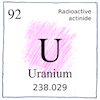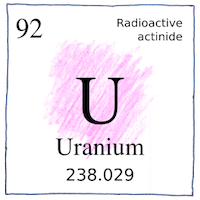Berlin, Paris—Martin Heinrich Klaproth,
Eugène-Melchoir Péligot
elements

|
Uranium
Martin Heinrich Klaproth precipitated a yellow compound from pitchblende, likely sodium diuranate, and assumed it was the oxide of a new element He heated his yellow oxide and got a black powder, actually an oxide of uranium, and assumed it was the new element. * Eugène-Melchoir Péligot took the black oxide and heated it with potassium to isolate uranium metal for the first time.
Atomic number 92
Klaproth named the element after the planet Uranus, which William Herschel had discovered eight years before. A mixture of three isotopes of uranium is found in nature—uranium-234, uranium-235, and uranium-238— and all are radioactive. Sufficiently concentrated, uranium-235 can sustain a nuclear chain reaction, releasing tremendous energy, which has been used for generating power and making nuclear bombs. Uranium-235 spontaneously decays with a half-life of 703.8 million years through a series of lighter and lighter elements—protactinium, thorium, actinium, francium, radium, radon, and polonium— eventually resulting in lead.
Unstable
The half-life of a human is considerably shorter than uranium’s. Time like sand in an hour- glass soon runs out.



Henri Becquerel discovered that uranium is radioactive in 1896. Before that, uranium ores were merely black and deceptively resembling lead ore. Pitchblende meant “black deceptive mineral.”
See also in The book of science:
Readings in wikipedia:
Other readings: